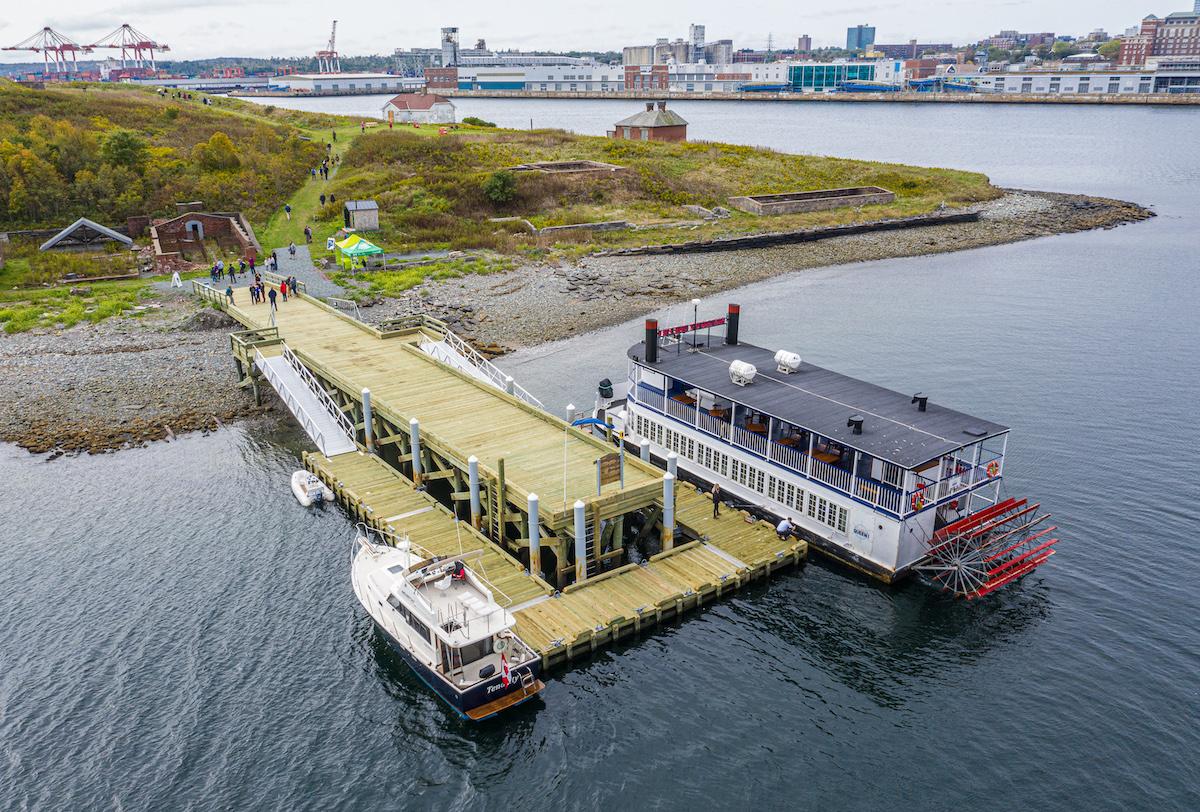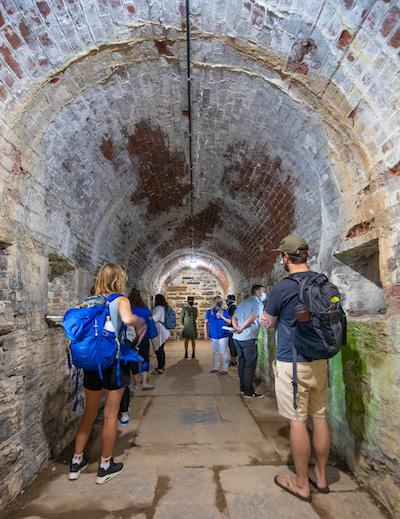First Look At Georges Island National Historic Site
By Darcy Rhyno
A party boat in the form of a double-decker, Mississippi-style sternwheeler isn’t what comes to mind when I think of transport to Georges Island National Historic Site in Halifax Harbour. But it is indeed a reservation aboard the Harbour Queen that gets me there. And yet, maybe it’s the perfect conveyance to help celebrate the opening of the island to the public after a 55-year wait. While Georges was declared a national historic site in 1965, it wasn’t until 2020 when Parks Canada installed a new wharf on the north shore that it became accessible.
Last October, on the final day of the shortened opening season — the only day a ticket was available — I become one of the lucky 6,203 visitors to the island. I find the sternwheeler docked at Murphy’s on the Water, the seafood restaurant that also runs wining and dining harbour tours aboard the ship. During the short, unhurried 15-minute crossing, Georges Island looms ever larger. The remains of Fort Charlotte crown the 4.84 hectare grassy drumlin. An automated lighthouse punctuates its western shoreline. The sternwheeler pulls in to the new wharf. Private boats are welcome to land here. Harbour Watercraft Tours and Adventures offers kayaking tours to and onto the island. How ever visitors arrive, they must land when the island is open — this year on Fridays, Saturdays and Sundays until September 5, and then weekends until October 10.
Parks Canada interpreters in World War II military uniforms greet us. One of them, project coordinator Emily Sine, hands me an interpretive brochure with a map identifying 22 points of interest. “It’s a self-guided tour,” Sine explains. “The brochure gives you an opportunity to wander the island. The tunnels themselves are guided.” She’s super friendly and ready with lots of information.

The Harbour Queen ferries visitors from Murphy's on the Water to Georges Island/Parks Canada, Mike Bayer
“We’re continuing to improve and open up more buildings,” Sine says of on-going conservation and interpretation efforts. “We’re going to be developing the landing area.” She indicates the excavation site behind her where the submarine harbour mining complex once stood. Components of the defensive minefield were built here in the 1870s, the latest in military technology of its time. If an enemy ship approached the harbour, a line of mines could be strung across the channels from both sides of the island and detonated via electrical cables. Today, crumbling walls, steel cribbing and a stout brick building are all that remain.
Map in hand, I head up the short road to Fort Charlotte, pausing at a roped-off, grassy knoll where visitors are perched — some in iconic Parks Canada red chairs — looking out over the harbour and onto the city’s waterfront that seems just a couple stone throws away.
Two single-storey buildings sit just beyond the barrier, their windows boarded up. The brick building once served as the married officer’s quarters. The other — the lighthouse keeper’s residence — is a squat cinderblock building, the white paint peeling from it. Just as with the mining complex, there is the sense that Parks Canada is just beginning to secure and plan for the development of the many points of interest on the island, untouched for half a century.

The upper battery, armed with guns protecting the parade square and tunnel entrances/Parks Canada, Mike Bayer
Near the top of the hill, I find an interpretive sign that tells the story of the island from the indigenous perspective. In the always descriptive Mi’kmaq language, the island is called Elpaqkwitk or “Water splashed on it by the waves.” From this vantage point, it’s easy to see why. The island sits near the middle of Kjipuktuk (pronounced Gee-book-took) or “the Great Harbour” facing the open Atlantic. Kjipuktuk is dotted with Mi’kmaq archaeological sites and Indigenous place names. Because it has always served as an important harvesting and gathering place, Mi’kmaq chiefs resisted construction of the first military fortifications by British forces, declaring, “where you build your fortress … is my land … the Creator gives me my territory forever.” Conflict over Kjipuktuk ended with the signing of the Peace and Friendship Treaties of 1760-61, but Georges Island remains part of the larger Mi’kma’ki territory — most of the Maritime provinces and a sliver of Quebec.
A second interpretive panel tells yet another tale of clashing cultures that played out here. Much of Mi’kma’ki was known as l’Acadie by French settlers. When Acadians refused to swear allegiance to the British Crown at a time of conflict between Britain and France, the British expelled the entire Acadian population. Le Grand Derangement or Great Expulsion continued from 1755 to 1764. British forces confiscated land, destroyed homes and shipped Acadians as far away as Louisiana where they became known as Cajuns. About 1,000 Acadians were held here with little shelter for some time. “For the Acadian community, Georges Island is a sacred site,” reads the sign. “It is a tangible connection to the human tragedy that played out here some 250 years ago.”
As I approach the entrance to Fort Charlotte itself, I find myself eye level with the top of the red-roofed pepperpot lighthouse, the first in Canada to be fully automated. The original was destroyed by fire, but even this replacement is a century old. Only by peering over the steep embankment can I see the full structure where it stands at the shoreline below. Turning around, I come to the bridge across the dry moat or ditch that surrounds much of Fort Charlotte.

The bridge crosses the moat or ditch surrounding Fort Charlotte/Parks Canada, Mike Bayer
As I enter parade square — the broad expanse of flat ground behind the stone battlements and gun emplacements — I spot a group of visitors gathered before the entrance to the rabbit warren of tunnels beneath the hill. I join them and wait for the tour to begin, suddenly feeling the weight of history here.
The star-shaped fortress and the fortifications that pre-dated it played a strategic role in the defense of Halifax from its founding in 1749 through various 18th century French-British conflicts, the War of 1812 and both world wars. The first structure was a humble affair of timber and earth. The Duke of Kent ordered it built and named it in honour of his mother, Queen Charlotte. It wasn’t until 1807 that the British military began planning for heartier fortifications. Tensions between the US and Britain were on the rise, and in addition to Malta, Gibraltar and Bermuda, this harbour was one of the four principal naval stations in the British Empire.
Because of its strategic importance, Halifax harbour was defended on all sides. Today, Georges Island is just one of five national historic sites that make up the Halifax Defense Complex. The most important is the Halifax Citadel National Historic Site built in 1828. Today, it’s the best preserved, easiest to visit and the most animated. The others are the round Prince of Wales Tower National Historic Site in Point Pleasant Park at the mouth of the harbour, York Redoubt National Historic Site on its southern shore and the remains of Fort McNab National Historic Site on the seaward end of less accessible McNabs Island. A committee struck in the early 19th century to assess Halifax’s military needs recommended replacing the temporary wood and dirt defenses on Georges with a masonry wall to connect the north and south gun batteries and a stone Martello tower, completed in December 1812. So well defended was Halifax Harbour, it never saw action.

On the tunnel tour, visitors are alerted about small spaces/Acorn Art & Photography
Interpreter Kate Barkhouse begins the tunnel tour with a warning. “People can get a little claustrophobic inside the tunnels.” Single file, we duck along tight passageways of brick and stone that turn voices into unintelligible echoes. We pass mysterious rooms and climb steep stairs. The air is dank and stale. It’s easy to imagine soldiers navigating by lantern light to the sounds of their own footsteps. At last, we emerge into an empty brick room with a vaulted ceiling.
“This is the main magazine,” Gunner Barkhouse says, playing her World War II role. “They kept their black powder in barrels. It’s the reason the whole tunnel system is here at all.” She explains that two soldiers were stationed here around the clock with one job, “to roll barrels around on the floor and look for signs that the powder wasn’t getting wet.”
As she speaks, I realize I was wrong about the light source. “Obviously, you can’t bring lanterns in here, so you’re only getting natural light from that shaft.” Barkhouse gives us a moment to imagine the anxiety levels of soldiers rolling kegs of gunpowder in near darkness.
“Come this way,” she motions. “The highlight of the tour is just through this next door.” We follow until, to my surprise, we emerge in the ditch surrounding Fort Charlotte. I pause to take in just how difficult it would have been for enemy forces to claim the island. Through a set of heavy doors, we enter the outer battery. In a room the shape of a mushroom cap, an 18-ton gun the size of a compact car is aimed through a small window towards the harbour mouth. In rooms to either side are similar guns.
“This is a 10-inch gun,” Barkhouse says. “It’s loaded from the front. The inside has rifling to put spin on the shot, which makes it more accurate and go a lot farther.” With more than a little enthusiasm, she gives us an idea of the gun’s muscle. “One of these at two miles can punch through eighteen inches of wrought iron.”
She says it took 17 men to move the beast on its rails, prep the 180-kilogram (400-pound) shot and load 18 kilograms (40 pounds) of black powder. The crew would then scramble from the room, leaving one brave soldier to fire the gun. As a comparison, Barkhouse says the gun at the Citadel uses half a kilogram (one pound) of black powder. “Imagine 40 times the sound of the noon gun here in this room. There would be debris bouncing back off the walls when the gun is fired, so they hung rope curtains.”
Barkhouse leads us outside to end the tour. She thanks us and we her. I hang back to ask why she’s so obviously passionate about the island. It wasn’t long ago, she says, that the lighthouse was operated manually. “The last lighthouse keeper, David Barkhouse, was my grandfather’s uncle.”
With a final thank you to Gunner Barkhouse, I make my way past more guns. Emerging onto parade square, the view of modern-day downtown Halifax is a bit jarring after the underground time travel. It occurs to me that it’s the experience of history against a contemporary backdrop that makes a visit to a site like Georges Island so rewarding and so popular. Visiting a national historic site is like driving with one eye on the rearview mirror — while moving ahead, we can also see where we’ve come from. As conservation efforts here continue. that view is becoming clearer all the time.

 Support Essential Coverage of Essential Places
Support Essential Coverage of Essential Places